January 2003Trading Tip:
The Grace Approach
by Alexander Grace
At http://www.edesks.com/ we
believe that human emotion drives the direction of all markets that
human beings trade. Our instruments are living; their mental and
emotional states of consciousness are constantly changing, and thus
varying the conditions under which our research is conducted. Above
all else, there is required a state of mind which is content to sit
down humbly before the markets and follow them were they lead
you.
It is fear and greed that are the two factors that jolt the
average person out of his usual thought habits. In all human
thinking there is a tendency to fall into step with the majority,
and every advance is instinctively resisted if it seems to go
against what is already held. Not only is it resisted, it is often
passionately resented, and the history of human emotion which even
shows only too clearly the depths to which even a rational personal
may sink. This is because of the power of the herd instinct within
each one of us, making us emotionally biased against any new idea,
which might upset the established order of things. So human beings
tend to do the same things repeatedly. And this tendency,
established through millions of years is a deeply rooted in all
human psychology.
The measurement of Greed and Fear and knowing when to use them to
your advantage is what we are interested in understanding at
www.edesks.com. How fear and greed are controlled is first and
foremost by proper money management! Once you have learned to use
proper money management the risks that are associated with trading
various markets will diminish greatly. This is because once you have
a set amount of money that you are willing risk in any one
transaction you will know how much jeopardy your money is at in any
given moment. This is the key to money management and to the
controlling of Fear and Greed. Through the establishment of simple
money management rules you control the value of your portfolio in a
method that will allow you to grow your money in a stair step
manner. Large bursts of cash are not proper and the only way you get
them is through luck or improper money management. If you can be
right even 40% of the time you have the ability to make money by
using proper money management. So the first thing that we believe in
and know that works is proper money management.
The next step is the understanding the measurements of fear and
greed are systematic in nature. There are various tools that we use
in our assessment of the markets that we deal with. Through the use
of technical analysis in conjunction with sentiment we come to the
conclusions of market direction. The process is repeated in the same
fashion over and that is the key to creating calmer investors or
traders which lead to better decisions. We believe that markets
repeat themselves because people continue to act the same way at
tops and bottoms of markets as they have throughout history and it
can be measured. In other words HUMAN NATURE never changes. This
method is used in stocks, bonds and commodities.
Words of wisdom from a Market Trader
Accept the rules that govern the markets and subordinate your
will to the will of the markets. Because the only place that you are
going to find a helping hand in this game is at the end of your arm.
The bottom line is you can and will fail many times, but you will
not fail until you begin to blame some else. So the first rule is to
remember that you are in a place where we all need to live by the
rules that govern our actions. These are the practical laws that
direct what goes on day to day in the markets. The rules that govern
the markets are not made not to be broken, and yes there are always
exceptions to the rules, but I always try to deal with the highest
probability of what is going to happen.
I am personally responsible for every transaction I make, and
never feel that any market has taken advantage of me. But that is
what we all want, the opportunity to use our intellect to change our
lives.
As each day unfolds in the markets, I have a specific mental
attitude that I try to keep. I never dwell on the past in any aspect
of my life, because there is nothing I can do about it. I always
look toward the future and maintain a positive attitude. I think
itís very wise to have a thought out scheduled time for studying the
markets. By setting a set time to do this, you will add to the
discipline that is so necessary to be successful in life as well as
in the markets. The markets allow those that are disciplined to make
money. Those without it will continually lose money.
Remember the market judges you based on your actions, not your
intentions. Itís a big step to take, admitting that you are in
charge of yourself, and that your decisions will make or break your
own fortune. Every trade outcome is my responsibility. The market
never goes against me personally, and in fact it doesnít know that I
even exist. I am personally responsible for every transaction I
make, and never feel that any market has taken advantage of me. That
is what we all want, the opportunity to use our intellect to change
our lives.
As you go through your trading life, remember that most people
will not accept losses. Without the reality of accepting loses, the
trader/investor puts themselves in the position of continually
losing money because they are willing to ride losing positions
indefinitely. The damage that goes on in riding a losing position
goes way beyond the dollar amount of the loss.
The damage is to your confidence and to your ability to think
clearly. By hanging onto your losers, you hurt yourself mentally.
This starts a chain reaction that for many traders becomes
insurmountable, and thus they have already lost before they even had
a chance to really start. A loss never brothers me when I take it,
because I know that Iím following the predetermined set of rules
that I trade by. What is harmful is when you rationalize yourself
into not taking the loss, even though you know that this is the
proper course of action. Hope is not a good thing in the markets,
because it keeps you from doing what you must do.
As opposed to hope, fear is actually helpful because fear will
help you in the protection against catastrophic loss. This one act
is what makes the difference between becoming a truly successful
trader, and or falling into the abyss with the rest of the world.
Thus the use of stops, no matter what time frame you are using, is
the difference between a professional investor/trader and the rank
amateur. The conclusions that I have reached after spending the last
20 years trading is that the market is the smartest animal on earth.
It is the meanest, and the most unconscionable beast that mankind
has ever had to deal with. It is right to fear this beast, for it
has taken many a manís soul. I respect the great beast beyond any
living thing, for it knows all, and I subordinate my will to its
will at all times.
Try to make greed and fear work for you, not against. Understand
that these are the normal human emotions of the masses, and that the
masses are usually wrong. At the top in whatever market you are
trading the bullish consensus is usually high, and at the bottom the
bearish sentiment is usually high. Sentiment indicators are of great
importance, because it gives you some idea of what the masses are
doing. There are various ways to measure sentiment readings in the
markets. The oldest published service is the Bullish Consensus out
of Pasadena, California with a product called Market Vane. There are
other services that measure market opinion: Investors Intelligence,
Consensus Index, and AAII Index and all are measures of market
sentiment. The trick with all these services is that you must look
at the historical ranges to see if indeed there is consistency in
the numbers at market tops and bottoms.
Every time I buy something, I never think of what I can make.
Rather, I think of what I can lose. By addressing the downside, I
set my parameters of risk right away and become discipline in my
approach. This discipline allows me to be wrong more than half the
time and yet still make money. Iím not saying Iím wrong half the
time, but with proper money management I can be and still make
money.
As I progressed as a trader/investor, I began to understand that
I had a very good opinion of the markets and that I approached each
market in the same manner.
Once I understood this approach, it made it much easier to trust
my own opinions. Where before I used to listen to other people, I
have evolved into a state where I just listen to myself. The one
undeniable truth that was beat into my head was that facts were
priceless, and opinions of others were worthless. So I found myself
going through the process of trying to justify my sources of
information, and trying to make sure that they have some experience,
some reason that I should listen. The reality of the markets is that
successful traders/investors isolate themselves from the opinions of
others. With the advent of the Internet, it is very easy for someone
or some company to become a market pundit. Do you really know who
these people are? Are they any good? With the Internet, even more
care must be taken about the type of information you get.
There are trading rooms around the country that actually have
very smart people that trade together. If you know these people or
the type of information or strategies they utilize, they can be of a
great help.
One important thing to do is always know your source. I have
actually received many good ideas by people who have pointed to
parts of certain markets that I have missed. As I received those
good ideas, I archived the people who made these calls. In the
future, I will be willing to take a look at what they are saying. If
I can have others that I trade with look at the same areas, and use
the same set of rules that I use to trade, then I will have a team I
can trade with.
This process of trading takes a complete understanding of oneself
to be successful. If you donít know who you are, this is not the
arena to find out; the cost is just too expensive. Overconfidence is
death to the trader, and there is no price too high to pay in order
to keep from becoming overconfident. A person must know themselves
thoroughly if they are going to make a living out of trading.
Patience is a major key in being able to ride a winner. Fear of a
big loss is so important, because it helps you to cut losses short,
and this improves your emotional well being, as well as your outlook
for future transactions. To persevere in this game, it is imperative
to keep your head clear and think rationally and have the
determination of a bulldog. There is a never-ending battle to
continually strive for patience, perseverance, determination and
rational action. If you donít know where you are, it is impossible
to know where you are going. When Iím in the market, I have a set
course of action and I try to always look at the time frame of the
day, the week, and the month that Iím in.
The markets are seasonal in nature, and must be approached in an
aggressive manner at different times during the year. Statistically,
the stock marketís best months are the last two months of the year
followed by the first month of the year.
There are more reasons for this than just the "January effect" on
stocks. Mentally, this is the typical period when the public and
money managers have their great expectations, and feel they have
done the necessary homework to profit in the coming year.
We all know that statistically the best months are November,
December, and January. Since I know that January has a large influx
of cash from mutual fund buyers, it makes sense to be long coming
into January.
This leads us into another strategy that I use each year that I
call Year Enders. Every year there is tax loss selling, and in some
years more than others. The key point being made here is that stocks
are getting thrown away because they have not performed. Because of
their lack of performance, they are being sold into the year-end
whether their outlook is bright or not, so that the investors will
be able to take advantage of the loss on their tax returns. So you
can see what is coming, these stocks have already had bad years.
Then they are punished and even more towards year-end in order to
take the tax losses. This act of tax loss selling depresses stocks
by even a greater margin than normal.
As a result, I buy into this action at the end of each year, and
hold for the January effect in the stock market. This is a powerful
tool and can give some very big gains early in the year. The usual
way I operate is to look for quality issues that have large cash on
their books, and will not go out of business in the next 12
months.
Again volume is a key in anything that I do, so the stock must
trade size. By size this usually means over a million shares a day.
Stocks need volume to move, and volume dictates price. This is a key
element in all the markets that I trade. Volume is the cornerstone
of price direction. So I always check the average volume on all
stocks I trade to make sure there is enough liquidity to enter and
exit at will.
I like to call stocks that trade large or "thick" volume." This
not only applies to stocks, but also to any market I trade, whether
it is currencies, bonds, crude oil, and so forth. You will never
find me trading anything that does not have liquidity, for this is a
great way to get trapped into a position that is not working out. I
fear no market that has a free flow of volume because I have the
confidence that I can figure out the direction as long as human
beings trade it. From the chaos of the masses is where opportunity
manifests itself.
I like the fear of the public because I know among the ruins
there are great opportunities. So what I look for is the fear from
the public and of friends, family, traders and anyone who is a
so-called pundit. I know myself and that is the most important part:
the fear and greed game. Know your stress point.
So how do we find something that fits this type of year-end
stock? In the winter of 2000, the NASDAQ took one of the worst
beatings in the history of the stock market. There were many stocks
that traded in the triple digits in March that ended the same year
below $10 a share. At the peak in prices of these various
securities, the investment community on Wall Street was busy placing
buy recommendations on stocks and talking about the new paradigm in
the economy. It was a sad thing for me to watch, because all the
classic signs of a top were there. I could not bring myself to buy
at these levels because the market has told me history does repeat
itself.
The prices that are made in the minds of men at market tops are
driven far beyond the rational expectations of rational men and are
solely based on greed. There was a massive bubble that was made in
March of 2000 which could be a top that will not be seen in many
years in the NASDAQ stock market. The point is that many Internet
stocks were at extreme valuations that could never be lived up to,
yet Wall Street kept recommending these very issues. At the top of
this foolishness, it was very difficult to find very many differing
views. The sad reality of any market is that the majority is always
wrong at the top and the bottom.
It is important to keep a logical perspective. Valuations do not
grow to the sky, and neither do they go to zero in a straight line.
Iím in the constant search for securities that no one wants, and
looking to sell my positions when everyone wants them. The crowd in
the market is usually on the wrong side.
The keeping of records is of great importance in your life as an
investor/trader. Limit the risk in any one position to a maximum of
10% of your capital, and the risk in all open positions to a maximum
of 25% of your trading capital. Determine this each day, adding
profits and subtracting losses in open trades, and combine this net
figure with your trading capital. Remember the term "mark to
market." This is what you must practice everyday to understand the
amount of equity you have. Always gather the amount of available
equity and margin daily.
I think that it is appropriate that I discuss the manner in which
I deal with losses. If I have taken a loss, I forget it quick. If I
have taken a profit I forget even quicker. I always try to keep my
greed and fear on the same level. It is important to keep your
thought processes clear. Celebration and lament have no place in the
middle of the trading day. No one can do anything about yesterday,
and when one opportunity ends a greater opportunity nearly always
lies in front of us. I try to take advantage of every loss to
improve my knowledge of the action of the market.
When I take a loss, it makes me become even more studious. On the
other side of the coin, the gains I make rarely give me reason to
study them. I expect losses and I have learned to accept them
gracefully. I have found that people who brood over losses always
miss the next opportunity, which more than likely will be
profitable.
Money does not sleep, and there is a change occurring somewhere
in the world that can make you wealthy. In trading, I regard fear as
the greatest sin and giving up as the greatest mistake. The art of
accepting failure is the step toward staying humble and a leap
toward victory. The preservation of capital is just as important as
the appreciation of capital. Losses never brother me when I take
them. When I fail to take a loss is I have put myself in jeopardy.
This is a key point, because this is how you can do permanent damage
to your equity and your ability to trade. Not to mention your
confidence! I have tried to get myself in the habit of taking my
profits too soon. I try not to torment myself if a trade continues
winning without me. Because most of the time it wonít continue long.
When they do continue, I simply look back on all the times when I
sold early to protect myself and helped preserve the gains that I
would have otherwise lost.
I never add to losing positions. I will buy on a scaled down
basis if that is the way I intend to enter a certain market. But I
never add to a losing position in order to average out. I stick to
the plans that I laid out.
I tend to worry about how much I can lose. I figure a risk reward
ratio ahead of my trades, and try to strive for at least three times
the potential profit versus the loss. A major point is not to
overweight without regard for the amount of capital that you have to
work with. When it comes to profits, itís a good idea to split them
down the middle, and to never risk more than 50% of them again in
the market. Another mistake is to take small profits just because
you have them. This will slowly kill you, and you will give away
good positions and not reap the rewards of the risk you have
taken.
The money that is lost in the short term is small compared with
the large sums lost by those who let their investment "ride".
Long-term investors are the biggest gamblers because after they make
a trade they often times stay with it and end up losing it all. The
intelligent thing to do is act promptly to hold losses to a minimum.
Wealth that is slowly built will continue to grow, but wealth gotten
quickly will dwindle away. I always regard that Iím at risk of ruin
when trading. It is important not to overweight your capital in any
one thing by taking huge positions. One wrong move, one wrong
report, one non-knowing event can end your career as a trader.
I try to keep everything simple when I trade. It is a very simple
act to place a mental stop loss on a trade, and yet executing it is
another thing. People tend to come up with many reasons not to take
a loss when it occurs. This is the most important aspect of trading,
whether itís long term or short term. There are a couple of ways to
use stops, either by actually physically placing the order in the
market, or by using a mental stop and selling it when it gets to
that price. The one good thing about putting it in the market is you
will not come up with reasons not to sell it or buy it depending on
your position.
"But wait, it may come back, the market is going to get better,
and itís different this time!" I have heard them all, believe me.
Never cancel a stop loss order after you have placed it at the time
you make a trade.
I have a scheduled, planned time for studying the markets. I have
used the weekends on Saturday morning to pick up my weekly issue of
Barronís newspaper for the last 16 years. This is part of the
work that I do each week in preparation for the following week. I
like to get a macro economic view of the world, week to week, and
the statistical information in Barronís (not articles) allows me to
take my time over the weekend and slowly let my thought processes
work through the necessary information. I have key areas that I work
through that let me understand the historic levels of greed and fear
in the marketplace. This paper is very useful in the sense of having
statistics that make it easy to get quick overview of the U.S.
economy. My study of the markets is a constant affair that never
ends, and each market day I wake at 5:00AM West Coast time. I like
to get up at this time in order to get prepared each morning. I see
what has gone on around the world, and what the bond market and
other various markets are doing each morning. The beauty of this
massive information flow is that the markets react right away to
what is going on, and you can capitalize on it. I try to think of
each market in its own world, and how one market may have an effect
on the other market.
The Proverbs of Trading and Investing
To know wisdom and instruction, to perceive understanding, and
to receive the fruits of proper judgment are what give a stable
income and the knowledge and the discretion of financial
freedom.
By planning what you do, and following your plans, you will
separate yourself from the common man who will drive you away from
proper teachings. The reward of seeking wisdom is the building of
wealth.
Keep records of your trading results.
Make sure you take a break from the markets. Get a detached
view of the markets, and a fresh outlook of the markets for the
coming several weeks.
Above all, the most important thing to do is to subordinate
your will to the will of whatever market you are involved in. As
long as you follow this commandment you will be safe. The day that
you lose sight of this you will be lost.
Always consider the amount of money that you could lose on any
transaction. The limiting of losses is the key to the markets, and
your life as a trader or investor. If you protect yourself, you
will be surprised by how far your winners will go.
Do not forsake the value of the gap. I will urge you not to buy
gap ups nor to sell gap downs in various markets. Study them.
Remember we are about always putting ourselves toward the highest
probabilities.
The beauty of the markets is that they all function the same
way. The one constant is that human natures dictates the movement
of prices based on fear, panic, greed, insecurity, anxiety, stress
and uncertainty.
Know your equity every day and understand the amount of money
in your account without exception.
Never let the minute to minute swings change your conviction of
where the market is going. Remember the key is to stick and stay
to make it pay.
The biggest mistake you can make is keeping a losing position
and selling a winning position. Remember sell your losers and keep
your winners.
Be more interested in a marketís reaction to new information
than to the piece of information itself.
Take care of yourself, and be mentally prepared for the rigors
that each day of trading brings. Try to keep this mental state from
the time you get up until the time you go to bed. By working hard
and understanding the key factors that are affecting the markets you
are in, you will have good fortune. In other words, the harder you
work the more luck you will have. Chance favors the prepared mind.
Analysis:
Stock Market of
10-14-2002
by Alexander
Grace
The dock workers strike was stopped for the time being with
President Bush stepping in which resulted in the union going back to
work under a 30 day contract. Probably the most intriguing statistic
of the Thursday session (10-10-2002) of last week is the phenomenal
number of new lows that continue to be made. On the NYSE there are
522 of them, compared to 9 new highs; NASDAQ showing 325 new lows
vs. 7 highs. This is the exact type of action what you want to see
at a major bottom.
The sentiment in the market is getting right and I think we have
seen the low sentiment readings on the S&P 500. In July the
Market Vane numbers got down to 17% bulls which is the lowest
reading I have ever seen in my lifetime. Currently it stands at 24%
bulls which is a very nice spot to start a rally from. And because
we did go to new lows in price in the S&P but not in the
sentiment I consider this another bullish divergence. The investor
intelligence numbers now are down to 38% bears and 31% these are the
lowest readings since the dead high of the NASDAQ stock market. I
point this out because markets always turn at the extremes and these
are showing fear loathing.
The Doctor indicator I use also should up in the way of them
buying bond funds. I love these guys they are the worst group of
investors in the world and they donít understand how markets
function it truly is a pity. Below I have a chart of the investorís
intelligence readings and as you can see the sentiment numbers got
down to 60% bears in 1995. Many people think that we have to have
these numbers get down to those levels before we can bottom. But
what people forget is that the stock market loves the wall of worry
and now we have it right in front of us. The numbers could become
more bearish as we move higher because of war uncertainty, the
coming elections, and skepticism about the economy. If this was easy
everyone would be doing this.
Common sense is always a good rule of thumb. Silly me I believe
that we will not have 4 years in a row of down markets. In 1932 in
the heart of the depression the stock market had it biggest rally
ever in the Dow Jones Industrials. The situation then was much
different than now the unemployment rate was 25% yes that is right.
1 out 4 people unemployed think about that for a minute. That is
scary what we have today is nothing we have low rates with an
economy that is starting to regain its footing after being smacked
in the face a couple of times. Tariffs were a mistake by President
Bush they never work. The September 11, 2001 bombing hurt the
economy and donít think for a minute that it wasnít meant to bring
the United States economy to its keens. The last smack in the face
was the dock workers strike and yet the economy is so powerful that
it continues to slowly grow. So is GDP going to
slow a bit? Yes it will but it will only be a hiccup on one
quarterís worth of numbers followed by serge the following
quarter. (Remember this!).
Keep the big picture in mind 6 months from now what will be
happening? The elections will be over the War against Saddam maybe
over and the rate cuts of the last 2 years will have worked there
way into the economy. Economies around the world will start spending
on technology and growth will continue. Rates will not be lower they
will be higher because of the growth of the economy.
Investor Intelligence


You can see the bullish divergence in the number of new lows in
the fact of lower market price and less new lows.

Over the last three month company insiders have been buyers of
stock across the stock market. The best news always comes at the top
in any market and the worst news always comes at the bottom.

The participation index has turned up another bullish
divergence.

VIX Index

The VIX index has now turned down which is another just flat out
buy signal. There are so many bullish divergences in the market it
is silly.
McClellan Oscillator
The McClellan has massive bullish divergences and is
giving buy signals. Every major indicator in the stock market is
turning up.
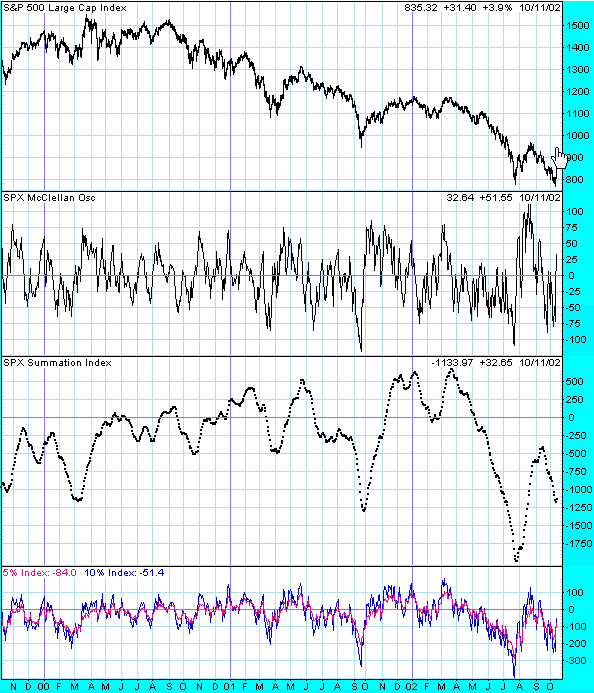
Put Call Ratios
Below are a series of put call chart going back to 1990. You will
see that the highest reading in the last 12 years was 1.10 on the 10
day moving average of the CBOE put/call ratio. After that reading
was registered the stock market started one of the biggest rallies
ever and it last over the next 6 years. The 10 day put/call of the
CBOE reached the 1.00 level in the past 2 weeks and that should be
enough to get us a sustained rally through the end of this year.
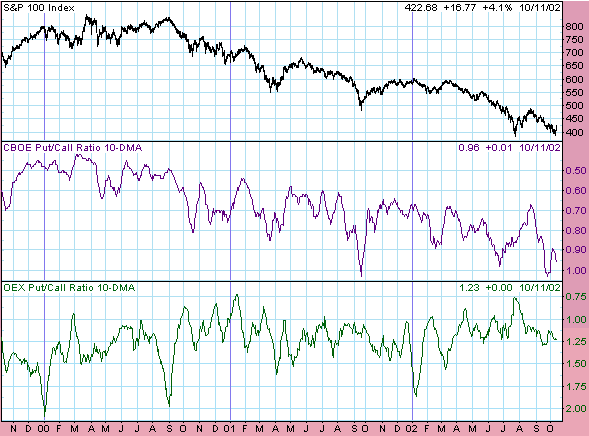

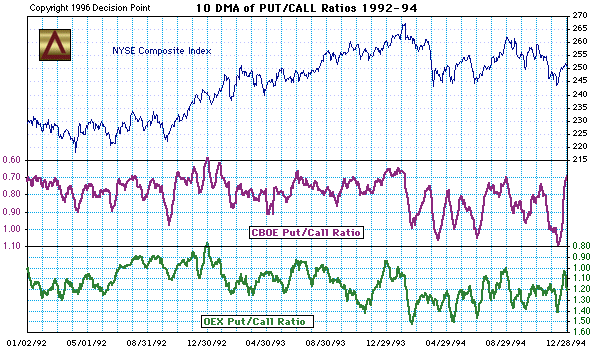
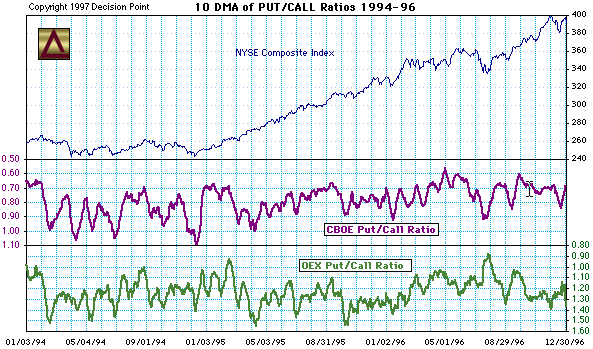
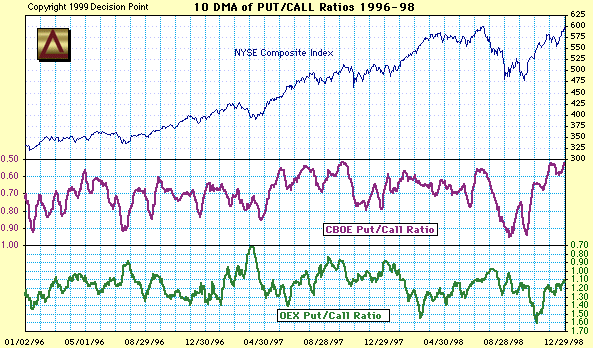
Rydex Ratio
This to me seems very clear that money now is coming out of bear
funds and looking for the long side of the stock market. That is a
blow off in the surge in the Rydex Bear Index assets.
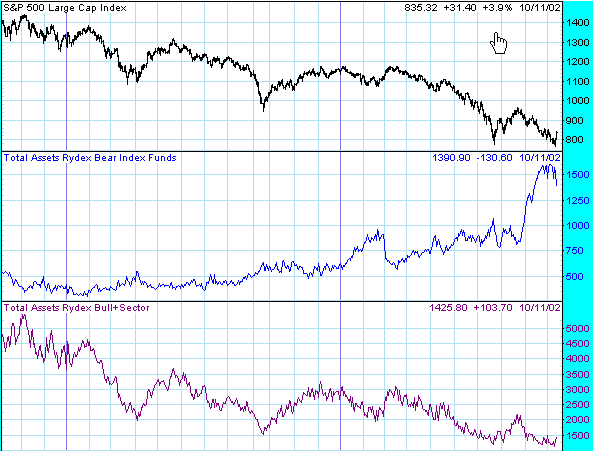
Climatic Volume Indicator
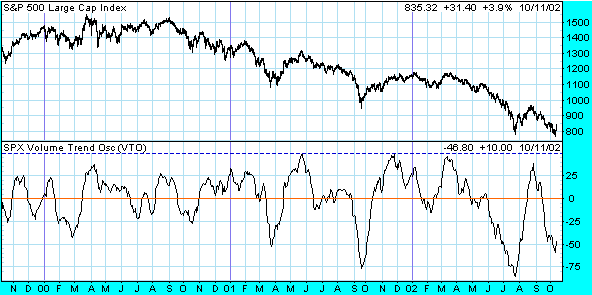
Will the Bullish divergences just not stop? How clear this one
is! New lows in the S&P and no new low in the indicator this is
yet another Bullish divergence.
TREASURY BOND FUTURES
(The Bonds are the safest to trade in of all markets
and a MAJOR LOW in interest has been put in.)
The best news always comes at the
top in any market and the worst news always comes at the
bottom. The bond market got the
best news they could get in the form of the dockworkers strike, loss
of GDP and weaker growth. That is bearish for the bond market!
Remember the bond market works contrary to economic numbers. Great
news for the economy drives interest rates higher and visa versa.
The economy of the United States has had nothing but bad news thrown
at it and that is why interest rates have gone lower. The last 100
basis points of yield in the bond market has come from a flight to
safety trade in the form of the public selling stocks and buying
bonds and real-estate. There is a house of cards built in the long
end of the bond market and as the stock market gets its footing you
will see a rise in interest rates.
DISCLAIMER: Information for the stock, bond or various
futures and option observations was obtained from sources believed
to be reliable, but we do not warrant its completeness or
accuracy, or warrant any results from the use of the
information. Your use of the various observations whether
it is stocks, bond, futures is entirely at your own risk and
it is your sole responsibility to evaluate the accuracy,
completeness and usefulness of the information. You must
assess the risk of any trade or transaction with your broker and
make your own independent decisions regarding any securities
and or markets mentioned herein.
Affiliates of
Alexander Grace LLC may have a position or effect transactions
in the securities described herein (or options thereon) and/or
otherwise employ trading strategies that may be consistent or
inconsistent with the strategies described above.
Copyright © 2003 Ė Alexander Grace
Trading LLC |